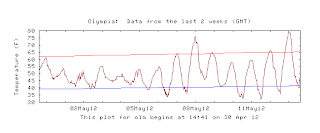On Saturday it became toasty here in Northwest, with many locations gets into the 70s and lower 80s. Yet a number of locations exprienced daily minimum temperature records in the morning--here is the proof from the National Climatic Data Center records website. The blue dot indicate a tie for the record and stations with an x set a record.
To see what was going on, take a look at the vertical sounding at Spokane, WA for 5 AM on Saturday morning. With high pressure we had clear skies (good infrared cooling) and light winds (less turbulent mixing of warm air from above). Thus, air near the surface cools efficiently at night. The air temperatures aloft have warmed considerably the past few days, much of it due to compressional heating from sinking air in the high. Thus, we have had surface-based temperature inversions (temps INCREASING with height). During the day, the surface is heating from the sun and the warm air is getting mixed down to the surface, thus temperatures soar.
The combination of cold air at the surface in the morning, and warm air aloft that mixed down during the day, was a huge diurnal range between the high and low temperatures---concrete-cracking range. Consider a few examples. Pasco went from 32 to 79: 47 F change!
While Olympia, went from 34 to 79. 45F increase. A few stations exceed 50F.
I don't much about plant physiology, but I wonder how plants tolerate such temperature swings.
And happy mothers day....Moms may need a sweater in the morning, but a short-sleeve shirt will be mandatory this afternoon, as many enjoy highs reaching into the upper 70s and 80s.
This blog discusses current weather, weather prediction, climate issues, and current events
Subscribe to:
Post Comments (Atom)
Drought Exaggeration
One of the most misused terms is drought . Certain groups and individuals are constantly using the "D" word when it is not appr...

-
In act one of this meteorological drama, yesterday and this morning brought heavy rain and flooding to many sections of western Washington. ...
-
The heavy rainfall is over, but some rivers are still rising. The most impactful atmospheric river event of the past few decades. Consider...






Yep! Here in Olympia we just had two mornings where I look across the street to see fairly well frosted roofs. It was like being back in Feb. or Mar.! Then a warm sunny day unfolds. Bizarre! Thanks Cliff for making sense of this strange interlude.
ReplyDeleteHi Professor Mass,
ReplyDeleteI've noticed the LGX radar showing impressive echoes the last couple days over the coastal waters, well away from shore. Satellites shows no clouds at all, and these echoes don't look like the occasional chaff streaks I see when the Oregon ANG F-15 jocks are out playing...
Could this be birds migrating that far from shore? Or are the Langley folks just into summer reruns from the more active time of year?
Interesting question in regards to plants. In the case of vineyards, my understanding is it's helpful in the fall, with the cool nights helpful for grape chemistry. Have always thought it was good in the spring too - relatively warm temps with cold nights acclimate the plants to the heat (and intense sunlight) to come. They are still cold hardy (to a point) and the heat is confined to a short period of time ... giving them small doses of what will soon be high doses. Just my kooky theory. Would like to hear what a real scientist thinks.
ReplyDeleteAgain, new squash sprouts DO NOT tolerate temps at freezing. That is the trouble with the Yakima Valley. High daytime temps and sometimes late, cold night temps.
ReplyDeleteCliff, feel very fortunate that you did not live in the Yakima Valley in the fifties, early sixties. The orchardists used to light the "smudge pots" in spring when temps would drop to freezing. The filth in the air was almost unimagineable. We have all seen fog. Imagine black fog. Really. Reality in the Yakima Valley.
But, smoking cigarettes was allowed anywhere and everywhere during that Golden Era.
LOL
"as many enjoy highs reaching into the upper 70s and 80s."
ReplyDeleteExcept out in Western Skagit County where the temp didn't get out of the mid 60's. 66F for a high here.
Hey Cliff, How much of a head start is this going to give us to the high-country hiking season?
ReplyDelete